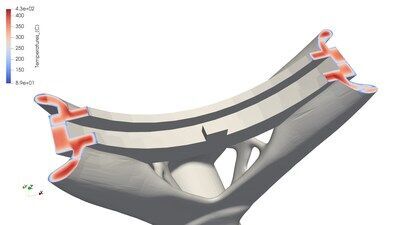One of the most exciting trends currently taking place in additive manufacturing (AM) is the development of simulation software for improving the predictability and repeatability of 3D printing technology. An increasing number of software companies are now in the mix, competing to offer their solutions to AM simulation. One of the most significant, of course, is Ansys (NASDAQ: ANSS), which is now working with German powder bed fusion (PBF) leader EOS to develop a metal 3D printing workflow that involves Ansys simulation tools.
Within the EOS Developer Network, Ansys will make it possible to enhance AM processes using simulation tools and then send models directly to EOS metal 3D printers. Ansys simulations will also rely on EOS-specific data, ,using its open-source application program interfaces, to improve simulation fidelity. This will reportedly result in better part geometries by predicting and compensating for any distortions that take place during printing, thus reducing build failures and, in turn, increasing 3D printer throughput. This print preview for metal AM stems directly from the software developed by Ansys acquisition 3DSIM.
Other features include improved material property selection, with simulations forecasting how design changes impact part microstructure. Altogether, the integration with EOS machines is said to increase design speed by 20 percent and simple print jobs themselves by 50 to 60 percent.
“Leveraging EOS scan vectors, Ansys simulations calculate and predict issues such as porosity, residual stress, thermal distortion and help users avoid potential blade crashes. This collaboration provides new levels of insight to users, making it easier for them to build complex parts more precisely,” said Shane Emswiler, senior vice president at Ansys. “Uncovering these issues early using simulation empowers engineers to select the correct parameters and understand if a part can be built as-is or must be redesigned — ultimately greatly minimizing the number of builds by substantially reducing trial-and-error failures, resulting in reduced material waste and substantial cost savings.”
For those who may not be familiar with metal PBF technologies, there are significant problems that companies like Ansys and EOS are trying to overcome. Due to the complex physics at work in the printing process, changes in temperatures and other variables can lead to such issues as warping, cracking and splattering of molten metal that can cause not only part failure but broken equipment.
Much of these problems have previously been only partially addressed with quality management mechanisms such as thermal sensors and cameras. However, as metal AM has been increasingly adopted for end part production, the requirements for such demanding industries as aerospace have dictated that printer manufacturers work harder to ensure the repeatability and quality of parts. This means that machine operators are no longer willing to perform seven or eight prints as a form of trial and error but are increasingly requesting first-time-right production.
3DSIM was among the earliest to develop simulation solutions for the problem, predicting any distortion that may occur in the printing process and then compensating. To gain an advantage in the 3D printing software space, Ansys scooped up the Louisville, KY startup. Other players developing simulation tools for AM are Hexagon, Altair, Siemens, PTC, Materialise.
According to the recent SmarTech Analysis report, “Opportunities in Additive Manufacturing Software Markets 2020”, revenues from AM software are expected to grow from $460 million in 2020 to an impressive $3.7 billion by 2027. It now seems as though traditional CAD and software companies are increasingly jumping into the market, just as major chemical companies have entered on the materials side and traditional manufacturers are involved in systems production. Simulation may be the key at the center of this entire network to ensure that the right materials will perform in a predictable way to produce quality parts reliably.
Subscribe to Our Email Newsletter
Stay up-to-date on all the latest news from the 3D printing industry and receive information and offers from third party vendors.
You May Also Like
3D Printing Financials: Steakholder Foods Balances Losses and 3D Printed Tech Advances in 2023
A pioneer in the field of 3D printed meat and fish, Steakholder Foods (Nasdaq: STKH) disclosed its 2023 financial results, a year highlighted by technological progress but overshadowed by financial...
3D Printing Financials: Protolabs’ Q1 3D Printing Revenue is Flat, Company Advances in Technology Push
Protolabs (NYSE: PRLB) has kicked off 2024 with a mild boost in revenue, revealing how the Minnesota-based company manages to adapt and thrive even in uncertain market conditions. While the...
Supply Chain Management and the Role of 3D Printing Digital Inventories
As the additive manufacturing (AM) industry grows beyond its humble roots as a rapid prototyping technology, it has been adopted by some of the world’s leading companies to produce not...
3D Printing Financials: Materialise’s Profitability Amid Revenue Dip in Q1 2024
Materialise (Nasdaq: MTLS) has released its first-quarter earnings for 2024, highlighting a challenging quarter with some key advances despite a dip in revenue. While navigating a mixed performance across its...
































